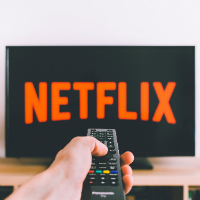 When the history of the evolution of OTT is written, the last few years will be remembered as minor skirmishes in the war for the living room. Over the next year or so, we’re going to see new streaming services from AT&T, Apple, Disney and Canal+, alongside revamped new joint offerings from existing broadcasters, like ITV and the BBC’s ‘Britbox’. But with so many services available, each with their own expensively assembled libraries, will it simply be a case of ‘best content wins’? Or will the consumption of content also be determined by the extent to which an app or platform can personalise the experience and keep users engaged?
When the history of the evolution of OTT is written, the last few years will be remembered as minor skirmishes in the war for the living room. Over the next year or so, we’re going to see new streaming services from AT&T, Apple, Disney and Canal+, alongside revamped new joint offerings from existing broadcasters, like ITV and the BBC’s ‘Britbox’. But with so many services available, each with their own expensively assembled libraries, will it simply be a case of ‘best content wins’? Or will the consumption of content also be determined by the extent to which an app or platform can personalise the experience and keep users engaged?
On the content side, many of the new entrants are investing heavily. For example, Apple has committed $1 billion to content for its new offering, while Disney is expected to spend around $500 million on new content for its own service – despite the fact that it already has a huge library of its own shows and films to populate the catalogue.
Meanwhile the incumbents in the market continue to spend on building out their own libraries – Netflix had budgeted around $8 billion for content last year.
Original content is quite rightly regarded as a key point of differentiation. Amazon Prime Video is reported to have paid around $250 million for motoring show ‘The Grand Tour’ to help get the service off the ground, and has apparently committed $500 million to a new ‘Lord of the Rings’ TV show.
Of course, broadcasters have known for some time that unique content is key to pulling in viewers, but perhaps most interesting is the way in which they have been pooling their resources to create original content that can have value across multiple markets. Last year for example, France Télévisions, Italy’s Rai and ZDF launched an initiative called ‘Alliance’, which will see them co-produce scripted content.
Personalisation, Recommendation and Publicity
But if original content is one way to differentiate, it may may not be enough on its own. A recent IHS Markit study on the launch of new subscription services said that with the market for video streaming services becoming “exceptionally competitive”, having a library of high-quality content “will soon not be enough to guarantee success, because there will be a large number of competitors with their own strong content libraries”.
One way to differentiate an offering in a crowded market is to find a niche audience whose needs aren’t currently being met on TV. Jon Watts, MTM co-founder and managing partner said that while the market for streaming services is becoming crowded, there are still opportunities for niche and thematic offerings. For example, companies with sports rights are seeing the opportunity to bypass broadcasters and pay TV operators to go directly to the consumer (DTC), as we’ve seen with F1 and WWE.
But ‘traditional broadcasters’ also recognise the need for a clearly defined offering. Eun-Kyung Park, chief digital officer of entertainment at ProSiebenSat.1 Media SE, agreed that it’s partly a positioning game. “It’s very important to distinguish yourself from others, because there is so much content out there,” she said. “What’s great about digital is you can create more niche offerings and you will find the audience, because it’s a ‘lean forward’ experience where the audience looks for you.”
“So we have one channel for example where we try out new things, try and break some taboos,” she said. “We have show like ‘Jerks’, which is a very successful comedy in Germany where the humour is very black and breaks a lot of taboos, so we’re positioned as ‘the cool kids on the block'”.
It is becoming increasingly clear that services carrying broader, mass-market entertainment libraries catering to all tastes, have to invest more heavily in their recommendation engines, to make sure users are able to easily find content they’re most likely to enjoy. “To fulfil its promise, OTT [over-the-top] has to get this balance right – it has to be personalised enough to be relevant to an individual,” said Brian Golbere, GM of emerging technologies at IPONWEB.
He said that this is one area where the bigger companies with lots of money to spend have a big advantage. “Netflix has 500 data scientists working on a problem – who’s going to compete with that?” he said.
Park agreed that personalisation and recommendation features are important and can make a streaming service more engaging for users, but emphasised that it’s vital to make sure you’ve got the basics right first. “You need a product that works seamlessly,” she said. “User experience and the user interface are super important – sometimes it’s not about the number of features you have, but it’s really about focussing on the core functions and making them work properly.”
A study carried out by nScreenMedia for content delivery network Akamai highlighted the importance of core functionality. For example, the study found that the time it takes for a video to start playing on a streaming platform can have a major impact on audience retention. “A two-second increase in start-up time can result in as much as 50 percent of the audience giving up on playing the video altogether,” said the report.
Park said the simple features, like users being able to clear content recommendations which they find annoying, and being able to skip title sequences for TV shows, can make a big difference.
Park also believes that streaming services must learn to recreate the promotional power of linear TV for promoting new content.
Netflix has been doing this more in recent years, prioritising its own original new shows and films on its home page, and running autoplay trailers for new content as the first thing users see when they log on. This seems to be working well – late last year Netflix claimed its original film ‘Bird Box’ was watched by 45 million accounts in its first seven days – despite somewhat lukewarm reviews (review aggregator Metacritic gave it an average score of 51/100).
But Park says there’s more that can be done – especially around replicating the publicity generated by live TV where audiences watch shows simultaneously. “It’s important that lots of people watch content at the same time,” she said. “Is a show a success because I do a lot of PR around it and force a lot of people to write about it? Or is it a success because people have to watch it at a certain time, and discuss it the next morning with their friends and colleagues?”
What does sustainable survival look like?
Whilst all of the above features can be helpful for drawing audiences on to new streaming platforms, and for retaining them, a large user-base alone isn’t enough if the business model simply isn’t sustainable. One of the big questions facing media companies pumping billions into content licensing and acquisition is whether subscription and/or ad revenues will be enough for these businesses to be sustainable. Things are complicated further still by the fact that the war for the living room is being fought out by a number of deep-pocketed adversaries, many of whom have other sources of revenue.
For ad-funded services, this means getting questions around ad load right, so viewers don’t switch off. “They need analytics around churn, why do people stay, why do people not stay,” said Golbere. “What’s the ad load that people can sustain? So if I’m watching, say, a cooking show at a certain time of day, I probably have a different tolerance for ads than I do at other times of day and with other programming.”
At the same time, the offering has to be appealing to advertisers too, with data targeting capabilities and a buying infrastructure that’s easy to trade on.
And Golbere says that all streaming platforms, whether subscription or ad funded, need to properly understand the value of their content, in order to guide their spending decisions sensibly. “I think if you look at the likes of Netflix and Hulu and Disney… they know pretty well what the value of their media is to current and future audiences,” he said. “Individual pieces might have some risk, but they know how many people watch a certain genre, they know what people like to watch and how they spend their time.”
Golbere said that this is something traditional broadcasters need to catch up on. “We’ve seen that play out with the rights for Friends for Netflix… Netflix knows the future value of that show to them way better than AT&T does,” he said.




